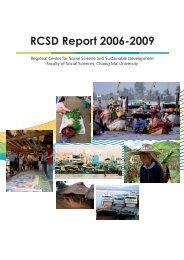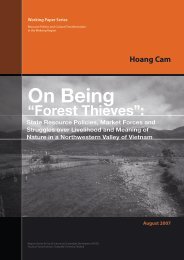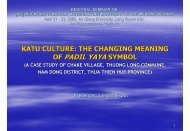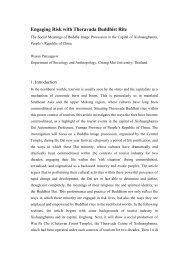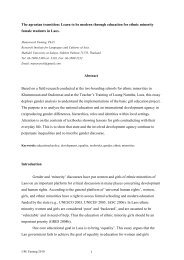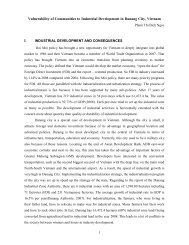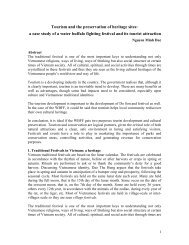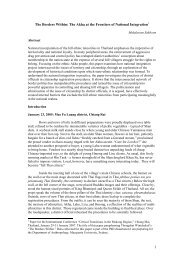Transformation after two decades of agrarian reform ... - RCSD
Transformation after two decades of agrarian reform ... - RCSD
Transformation after two decades of agrarian reform ... - RCSD
Create successful ePaper yourself
Turn your PDF publications into a flip-book with our unique Google optimized e-Paper software.
landholdings back in their provinces. These legislators were not only political elites, but were,firstly, <strong>agrarian</strong> elites.Fragmentation <strong>of</strong> Land, Redistribution <strong>of</strong> Power?In the Philippine countryside, land remains in the core <strong>of</strong> resource conflicts, and parallel to these,<strong>of</strong> the rural development agenda. The dichotomy between the landed and the landless continuesto define the political, economic, and socio-cultural landscapes <strong>of</strong> the rural areas. In a countrywhere most people still depend on agriculture, land remains one <strong>of</strong> the most important “factor <strong>of</strong>production” or capital. However, it is also true that land is more than an economic factor. It haspolitical and social functions such that in many rural areas in the Philippines, control <strong>of</strong> the landmeans control <strong>of</strong> the people within this land. Land-owning entities occupy the upper tier <strong>of</strong>society – they are the wealthy, the force that can dictate the development trajectory (or lackthere<strong>of</strong>) <strong>of</strong> barangays, towns, even provinces, they are the ones whereupon the landless aredepending on for socioeconomic and political security. Land means power.The series <strong>of</strong> <strong>agrarian</strong> <strong>reform</strong> programs in the Philippines aimed to rectify the problem <strong>of</strong>inequality based on land ownership through the redistribution scheme. The ComprehensiveAgrarian Law <strong>of</strong> 1988 mandated the abolishment <strong>of</strong> the tenancy system in the country to makeway for a society where first, no one is excluded from access to land and other capitals, and <strong>two</strong>,access to these resources is equal for everyone.More than the fragmentation <strong>of</strong> lands, land redistribution projects have more pr<strong>of</strong>ound effects.Going back to the premise <strong>of</strong> the CARP, it aims to upset the existing power relations between thetenants, farm workers and other beneficiaries and the landlords by providing a “level” playingfield. For the past <strong>decades</strong>, a number <strong>of</strong> studies conducted particularly by the Popular Institutefor Democratic Studies (PIDS) (see Llanto & Dingcong, 1991; Sanchez, 1991; Geron, 1994;Reyes, 2002; Llantos & Ballesteros, 2003; Ballesteros & de la Cruz, 2006; Adriano, 2008;Ballesteros & Cortes, 2008; Leonen, 2008) assessed the socioeconomic impacts and policyimplications <strong>of</strong> the CARP. Most <strong>of</strong> these studies reflect the failure <strong>of</strong> the program in achievingits goals, thereby, presenting only pictures <strong>of</strong> a “stagnant” rural, i.e., low-density in terms <strong>of</strong>settlements; agricultural, i.e., land use is still predominated by crops production, countryside,7




